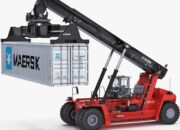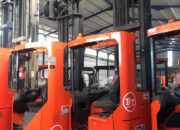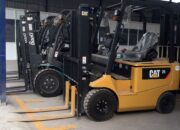10 Essential Spare Parts Every Container Handler Warehouse Must Stock
A multi-billion–dong container handler standing idle — halting the entire logistics chain and causing massive operational losses — simply because of one unavailable spare part. This painful yet all-too-familiar scenario occurs at many ports and depots. The cost of downtime per hour far exceeds the cost of keeping essential spare parts in stock.
Operating in harsh conditions, constantly lifting loads weighing tens of tons, and exposed to salt-laden air, container handler components wear out rapidly. Therefore, the smartest maintenance strategy isn’t “repair after failure”, but rather proactive maintenance with critical spares on hand.
1. Filters (Oil, Fuel, Hydraulic, Air)
Why it’s critical: Filters are the “lungs and kidneys” of a container handler. They remove contaminants, metal particles, and impurities to protect the engine, hydraulic system, and other costly components from wear and damage.
Replacement indicators:
Reduced lifting power or engine performance.
Warning lights for oil or hydraulic pressure.
Black smoke emission from the exhaust.
Follow the manufacturer’s service interval strictly (e.g., every 500 operating hours).
Stocking benefit: Filters are the most frequently replaced consumables. Having them in stock ensures scheduled maintenance can be performed on time, avoiding unnecessary downtime due to missing parts.
2. Hydraulic Hoses and Fittings
Why it’s critical: The entire lifting power of the machine is transmitted through the hydraulic hose system.
Replacement indicators:
Bulges, cracks, or blistering on the hose surface.
Hydraulic oil leaks at bends or fittings.
Sudden hose bursts — a dangerous failure that stops the machine instantly.
Stocking benefit: Enables quick field repair of leaks or hose bursts, minimizing expensive hydraulic oil loss and reducing downtime from several days to just a few hours.
3. Twistlocks and Twistlock Sensors
Why it’s critical: Twistlocks are the locking devices that directly engage with the container corners, enduring extreme load, vibration, and impact. Sensors ensure safe locking/unlocking operations, preventing catastrophic accidents.
Replacement indicators:
Worn, cracked, or deformed twistlocks.
Stiff or jammed locking operation.
Frequent twistlock sensor alarms on the operator display.
Stocking benefit: Ensures absolute operational safety and compliance with inspection standards. Worn twistlocks must be replaced promptly to prevent container drop accidents — the most severe risk in container handling.
4. Brake Pads and Related Components
Why it’s critical: Stopping a multi-ton machine requires a perfectly functioning braking system. This component directly affects operator safety and overall site safety.
Replacement indicators:
Squealing or grinding noise during braking.
Reduced braking efficiency or extended pedal travel.
Brake fluid leakage at wheel ends.
Stocking benefit: Ensures the machine always meets safety standards and can continue operation without waiting for parts delivery.
5. Drive and Accessory Belts (Engine, A/C, Alternator)
Why it’s critical: These small rubber belts drive vital engine components such as the alternator, cooling water pump, and air-conditioning compressor. A broken belt — especially the water pump belt — can cause engine overheating and severe damage worth millions of dong.
Replacement indicators:
Cracks or glazing on the belt surface.
Squealing noise when the engine is running.
Stocking benefit: Inexpensive yet vital. Keeping spare belts allows replacement within minutes, avoiding costly breakdowns.
6. Fuses, Relays, and Electrical Junction Boxes
Why it’s critical: These are the silent protectors of the machine’s complex electrical and electronic systems, guarding against overcurrent, short circuits, and fires.
Replacement indicators:
Sudden loss of function (lights, horn, wipers, etc.).
Repeated fuse blowing — a warning sign of deeper electrical faults.
Stocking benefit: Compact, inexpensive, and indispensable. Keeping spares significantly speeds up electrical troubleshooting and repairs.
7. Sensors (Position, Pressure, Temperature, etc.)
Why it’s critical: A modern container handler is like a giant robot — sensors are its “senses.” They provide real-time data to the ECU (Electronic Control Unit) for precise, efficient, and safe operation.
Replacement indicators:
Fault codes displayed on the dashboard.
Irregular operation, power loss, or RPM limitation.
Stocking benefit: A single faulty sensor can immobilize the machine. Stocking common sensors (crankshaft position, camshaft, oil pressure, etc.) ensures rapid recovery and minimal downtime.
8. Hydraulic Cylinder Seal & O-Ring Kits
Why it’s critical: These rubber seals maintain internal hydraulic pressure and prevent oil leakage, enabling the cylinders to perform heavy lifting tasks.
Replacement indicators:
Oil film or leakage around piston rods.
Weak or drifting cylinders unable to hold load position.
Stocking benefit: When overhauling or resealing a cylinder, having the correct seal kit on hand saves significant time compared to dismantling and measuring for replacements later.
9. Work Lights, Signal Lamps, and Horns
Why it’s critical: Essential for safe operation during night shifts, poor weather, or in busy port environments.
Replacement indicators:
Dim or non-functional lights.
Horn not working or producing weak, distorted sound.
Stocking benefit: Quick and easy to replace, ensuring compliance with occupational safety standards and readiness for 24/7 operation.
10. Bearings and Bushings
Why it’s critical: Found in all rotational and pivot points (wheel hubs, sheaves, lift frame joints, etc.), bearings and bushings reduce friction and carry heavy loads.
Replacement indicators:
Unusual grinding or knocking sounds from joints during travel or lifting.
Excessive play or looseness in linkage points.
Stocking benefit: Prevents secondary damage to expensive parts like shafts, hubs, or housings. Timely replacement saves major repair costs and avoids extended downtime.
Conclusion
For port operators and logistics depots, proactive spare parts inventory management isn’t an expense — it’s an investment in uptime. Stocking the 10 critical items above ensures your container handler fleet stays reliable, safe, and ready to perform — minimizing downtime, maximizing productivity, and protecting your bottom line.







